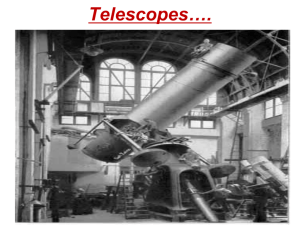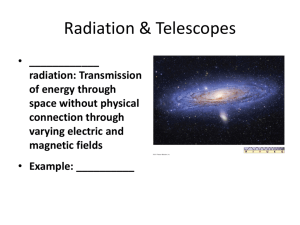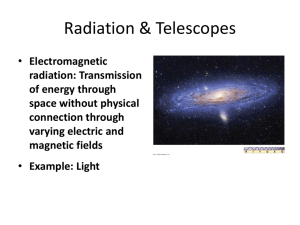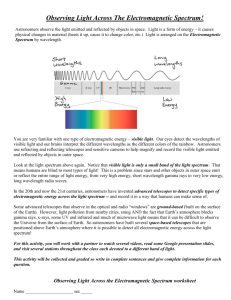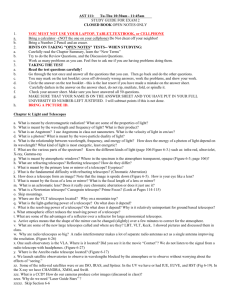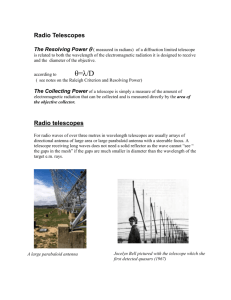Astronomy 3
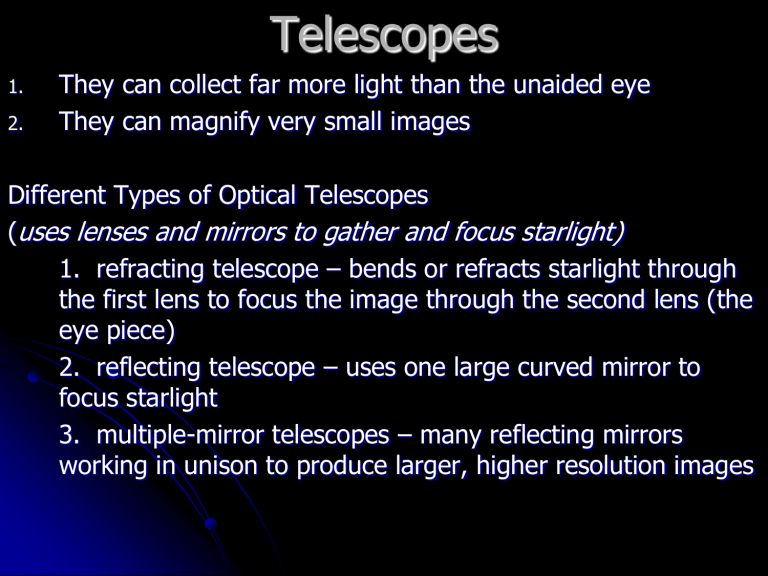
1.
2.
Telescopes
They can collect far more light than the unaided eye
They can magnify very small images
Different Types of Optical Telescopes
( uses lenses and mirrors to gather and focus starlight)
1. refracting telescope – bends or refracts starlight through the first lens to focus the image through the second lens (the eye piece)
2. reflecting telescope – uses one large curved mirror to focus starlight
3. multiple-mirror telescopes – many reflecting mirrors working in unison to produce larger, higher resolution images
Refracting Telescope
Reflecting Telescope
Mt Palomar 200" Reflecting Telescope
Multiple-Mirror Telescope Observatory in Mt. Hopkins, Arizona
Telescopes (cont.)
Famous Telescopes
Schmidt Telescope – uses both reflecting mirrors and refracting lenses
Telescopes (cont.)
Famous Telescopes
Hubble Telescope – reflecting telescope orbiting Earth, has unparalleled resolution and usable for ultraviolet detection that is not possible from Earth’s surface
Other Types of Telescopes
Spectroscope – uses a prism to separate visible light and determine the chemical composition of a star
E.W. Maunder (at the eyepiece) and W.
Bowyer observing with the half-prism spectroscope, c. 1894
Radio Telescope – very large telescope that picks-up radio waves emitted by quasars and pulsars
Arecibo in Puerto Rico (1000’ dia.)
The Very Large Array (VLA) in
San Agustin, NM →→→→→
Electromagnetic Spectrum
The elecromagnetic spectrum includes all forms of radiation,
7% of which is visible light -- the radiation to which our eyes
are sensitive.
The spectrum up according to the wavelength of the radiation.
Electromagnetic Spectrum
Doppler Effect
The apparent change in the wavelength due to an object's motion
Sound: like the whistle on a train or a car horn as it goes past.
Doppler Effect
Red shift – as an object moves away – the wavelength the star radiates gets longer … toward the RED end of the spectrum
The faster the distance increases the greater the
‘Red Shift’
The object is moving away from us
Doppler Effect
Blue shift – as an object moves toward – the wavelength the star radiates gets shorter … toward the BLUE end of the spectrum
The faster the distance decreases the greater the
‘Blue Shift’
The object is moving toward US
Parallax the apparent displacement of an observed object due to a change in the position of the observer http://sci2.esa.int/interactive/media/flashes/2_1_1.htm
Parallax http://sci2.esa.int/interactive/media/flashes/2_1_1.htm


